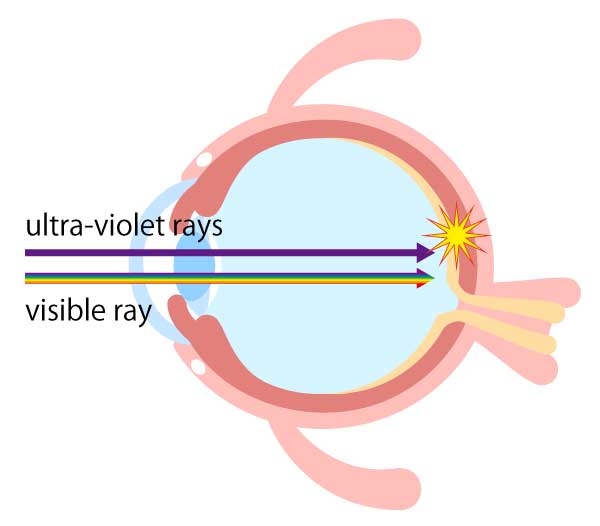Difference between 265~280nm deep-ultraviolet LED and 405nm near-ultraviolet LED
Disadvantages of 265~280nm deep-ultraviolet LED
The wavelength of 265~280nm deep-ultraviolet LED has a strong sterilizing effect, but it also has a bad effect on the human body.

Illustration of ultraviolet rays entering through the eyes
For example, blue light has the following effects:
Effect on eyes
- Damage to the retina
- Eye strain
- Eye pain
Effect on the human body
- Sleep disorder
- Obesity
- Cancer
- Mental state
265~280nm deep UV LED is the light with a wavelength that is blocked by the ozone layer and does not reach the ground under natural conditions. It is strong compared to blue light of which the wavelength is 380 to 500 nm. Exposure to deep-ultraviolet light can cause severe eye damage and skin damage. Therefore, deep-ultraviolet LEDs can be used only for limited purposes such as sterilization of places where there are no people like hospital operating rooms or water purification.
Advantages of 405nm near-ultraviolet LED
On the other hand, 405nm near-ultraviolet LEDs resemble the sunlight and have no effect on the human body, and their sterilizing effects have already been proven.

Light wavelength and positioning of 405 nm
(Table) Inactivation of COVID-19 by using 405nm near-ultraviolet LED
| Irradiation time (min) |
Virus inactivation rate (%) |
| 0.5 |
0.5 |
| 1.0 |
90.0 |
| 5.0 |
99.74 |
(Irradiation distance 20mm)
Since it has little effect on the human body, it can be used for indoor and outdoor lighting in the same way as general lighting, and it can also be used for medical applications such as endoscopic cameras and catheters. Furthermore, as the table shows, 99.74% of coronavirus inactivation has been demonstrated by irradiation for 5 minutes at an irradiation distance of 20 mm. Therefore, it can be used to remove viruses both inside and outside the body. The 405nm near-ultraviolet LED is LED that can be used in a wide range of applications.



